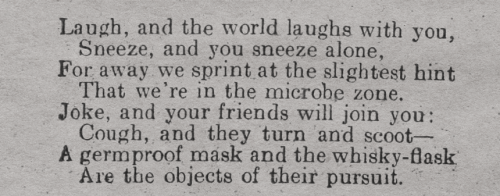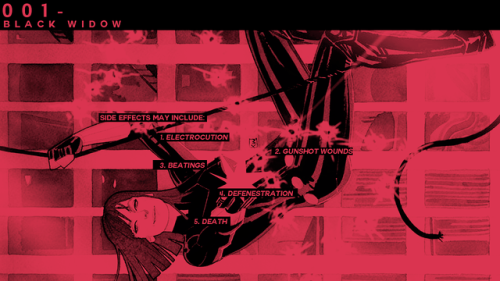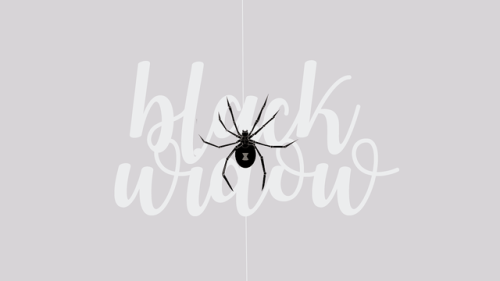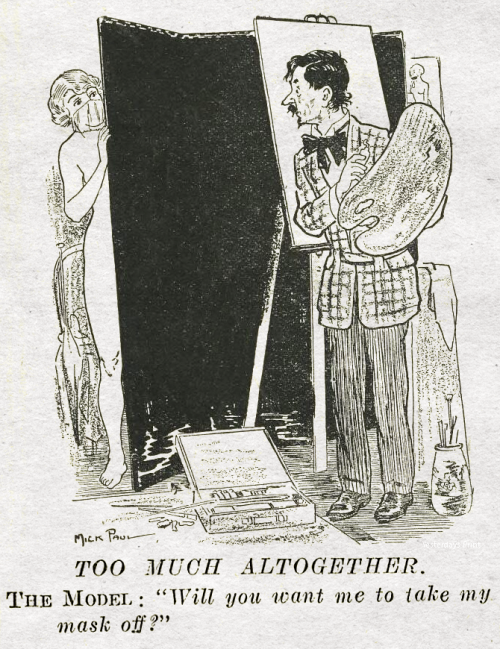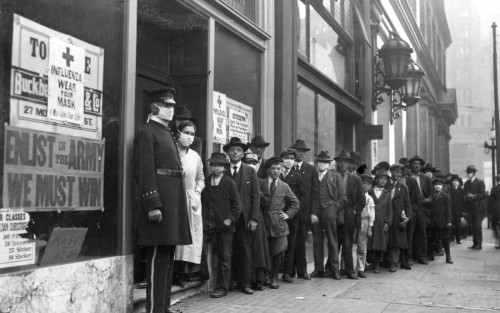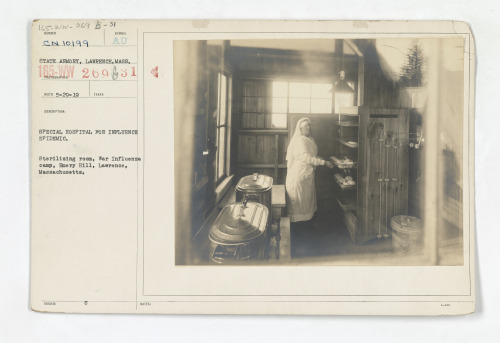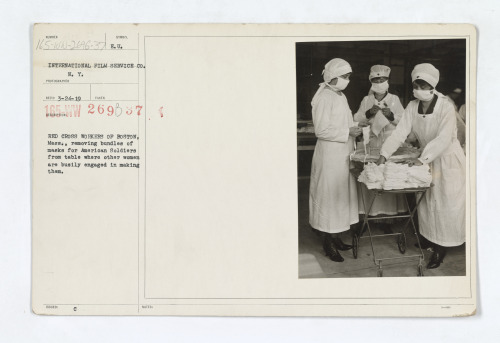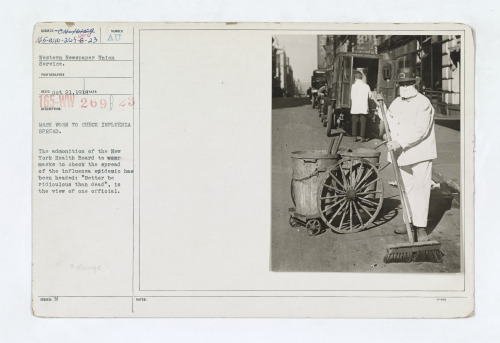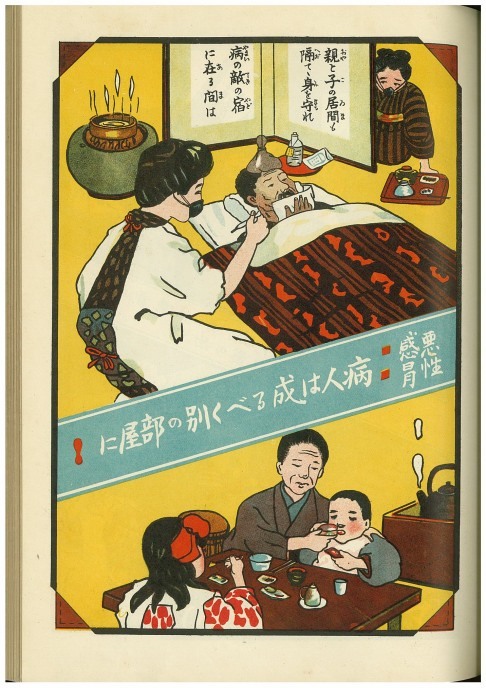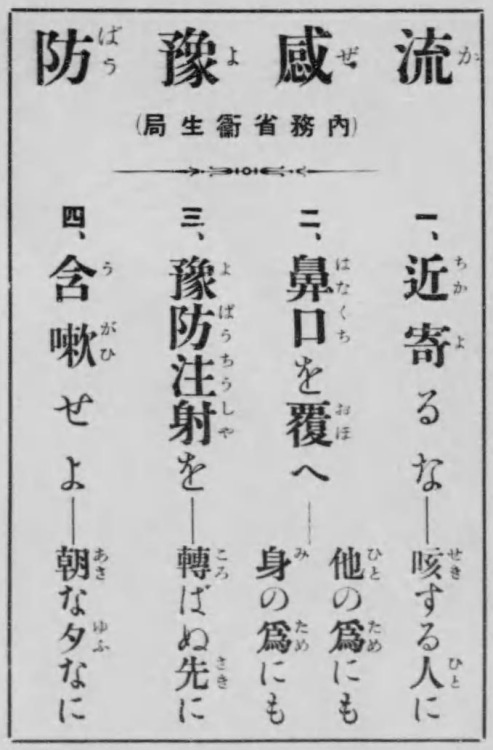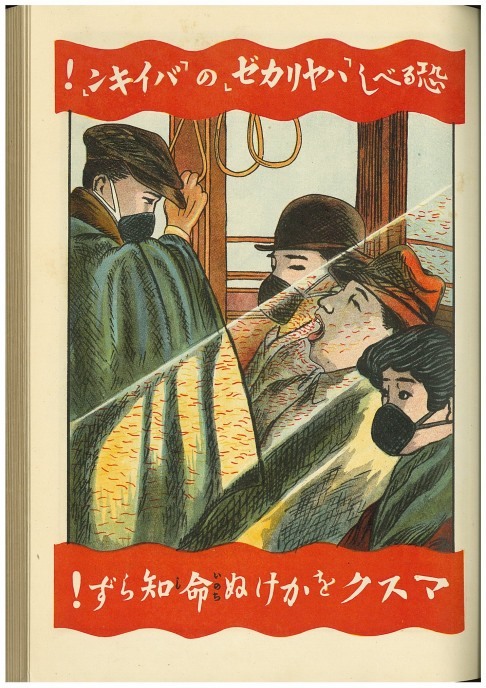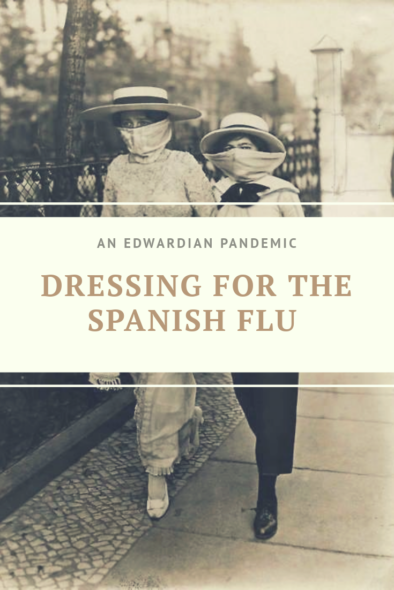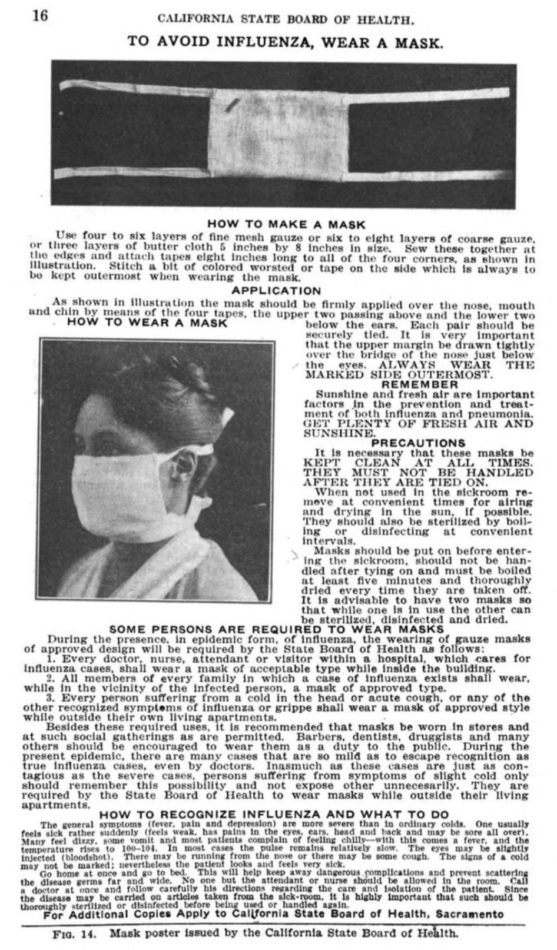#spanish flu

A streetcar conductor in Seattle not allowing passengers aboard without a mask during the Spanish Flu pandemic, 1918.

“Wear a mask or go to jail” , California, 1918.
People stand together while wearing masks in an effort to protect themselves from the Spanish Flu. The 1918 Spanish flu killed up to 50 million people around the world and has been called “the mother of all pandemics”.
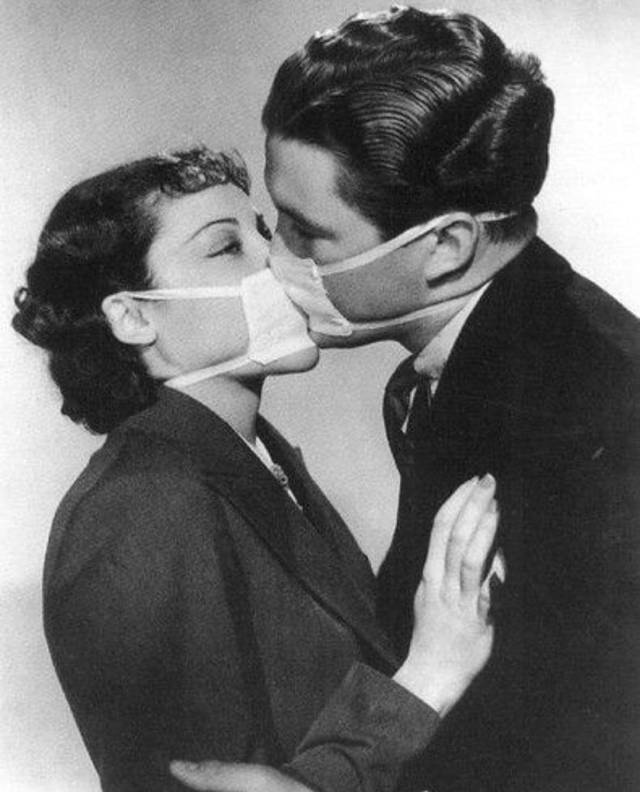
Couple kissing with surgical masks to prevent infection during a flu epidemic, 1937.

“Please Don’t Kiss Me!” A mom asks not to kiss her baby to avoid catching the flu, 1939.

Spanish Flu, 1918. Family Portrait.
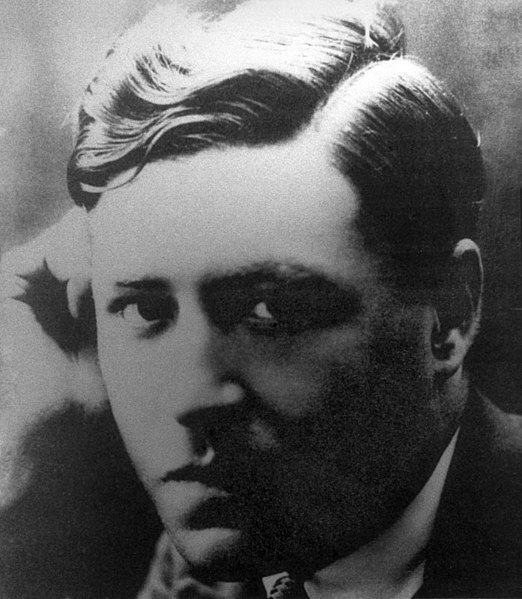
In 1918, Josep Pla was studying law at the University of Barcelona when the disease known as Spanish Influenza broke out. The university closed in the middle of the semester and Pla returned to his family home in Palafrugell, the small city in the Mediterranean Costa Brava where he had been born. At this point, Pla began keeping the diary that would become The Gray Notebook(translated by Peter Bush for NYRB). The very first entry mentions the influenza, his return to Costa Brava, and his innocent first days back home:
8 March. There is so much influenza about that they’ve had to shut the university. My brother and I have been at home in Palafrugell ever since. We are a couple of idle students. I only see my brother at mealtimes; he is a very keen football player—despite breaking an arm and a leg on the pitch. He leads his life. I do what I can. I don’t miss Barcelona, let alone the university. I like small-town life here with my friends.
Later entries about the flu are much less carefree. Over the course of the outbreak, an estimated 250k+ people died in Spain alone, and by the following fall, Pla and his family were attending funeral after funeral. His description of taking the train home after one such funeral, written on October 18, 1918, is particularly haunting:
The small train takes us home in the evening, in the dim, murky carriage light. The engine sputters despairingly and sparks fly up from the chimney. The train is full. People sit in subdued silence. Those coming from market imitate those who’ve been to the funeral. If one imagines a train full of thinkers, this would be it. The brims of our hats cast shadows over our faces. What are we thinking? Nothing at all, I expect. The drama derives from the fact that there is so much here we cannot understand—so much that it renders the mechanics of our minds quite useless.
In an entry February 21, 1919, after Pla has returned to Barcelona, he remarks on the eerie quiet that has fallen over the city:
Barcelona is remarkable tonight. Everything has been plunged into darkness. It is so astonishing it is literally beyond words. The silence is what’s most striking—the deep, deep silence. You can hear neither the distant wail of vessels setting sail nor distant trains. Nothing at all. It’s like living under the heaviest slab of lead.
Pla was ill at this time himself, but thankfully he recovered, much to his father’s surprise, as recorded in an entry from February 25, 1919:
My father, who has just arrived from Palafrugell, thinking he will find me on my sickbed, is shocked to see me reading when he walks into my bedroom. We talk at length.
Photo: Josep Pla, 1917 © Josep Pla Foundation/Josep Vergés Collection, released by Fundació Josep Pl on Wikimedia Commons (license).
All images and captions are from The Guardian. It’s interesting to see how society has evolved to respond to global pandemics over the last 100 years. Fun facts about Spanish Flu:
- It is not known where the Spanish Flu originated
- The Spanish Flu became associated with Spain because Spain was not subject to the same media blackouts and was hit hard by the flu.
- The Spanish believed that the flu originated in France and called it the “French Flu”
- The First known case of Spanish flu was March, 11 1918 at Camp Funston in Ft. Riley, Kansas, USA.
- Quarantines and mask wearing were required in areas.
- Aspirin was used to combat the Spanish flu, and the recommended dose was up to 30 mg/ day, which is toxic.
- Many deaths from Spanish flu were caused or sped up by aspirin poisoning
- The Spanish Flu is often called the “Forgotten Pandemic” as it occurred in a time of media blackouts and did not have extensive reporting.

“Clean, clear and soft skin was how soap was sold before the flu took hold. (Manchester Guardian, January 1918)“

“The antiseptic cleanliness of Lifebuoy tackled the “influenza scourge” and left the whole family in “smiling health,” claimed its makers Lever Brothers. (Manchester Guardian, March 1919)”

“As more people died of flu, the tone of adverts changed. Boots placed an advertorial that encouraged washing with soap, and quoted the Ministry of Health: “Our country’s greatest asset is its people.” (Manchester Guardian, April 1919)”

“An increase in demand for soap led manufacturers to ship more raw materials from abroad. (Manchester Guardian, February 1920)”

“Jeyes disinfectant – either in liquid or soap form – was promoted as being invaluable when tackling germs in the home, school and office. (Manchester Guardian, May 1919)“

“A versatile soap, Ivy, could be used for many cleaning tasks, including washing delicate materials like lace. (Manchester Guardian, April 1922)“
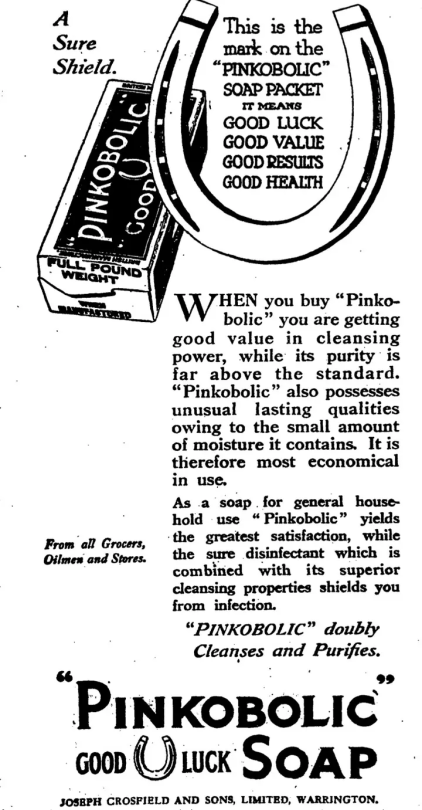
“Pinkobolic soap claimed to be both effective and economical. (Manchester Guardian, June 1920)”

“The makers of Sunlight soap commissioned a series of adverts that introduced readers to different people living on “Sunlight Street”. This advert featured a mother and her children who, thanks to Sunlight soap, benefited from clean and healthy surroundings. (Manchester Guardian, May 1922)“
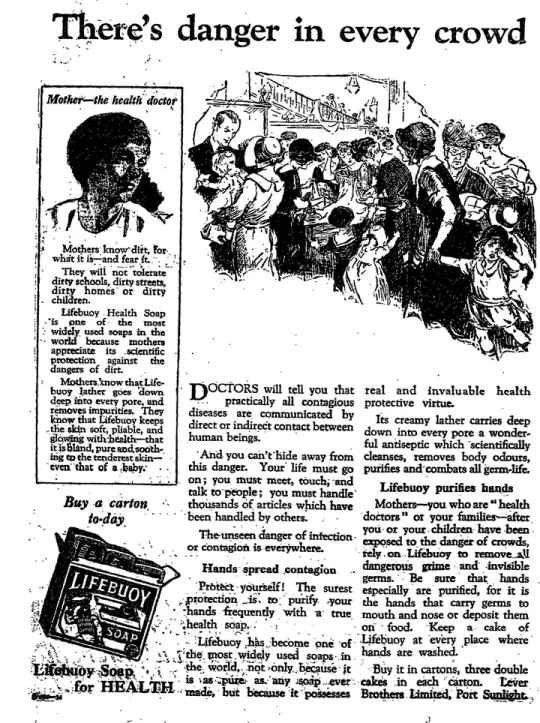
“Despite unforeseen dangers of infection and contagion “Your life must go on; you must meet, touch and talk to people…,” said this advert. (Manchester Guardian, June 1924)“

“Everything from influenza to burns were said to benefit from the antiseptic product Yadil. It was sold as a soap, ointment and liquid. (Manchester Guardian, November 1928)“
流行性感冒 内務省衛生局 著 1922年
国立国会図書館デジタルコレクション
流行性感冒 ポスター(カラー)
国立保健医療科学院 所蔵貴重書
※大正10年(1921年)1月6日 内務省訓令 “斯クテ各般ノ學説文獻ノ調査考究ノ結果ト海外視察員ノ報告ト學者實地家ノ意見トヲ精渉審議シテ左ノ如キ流行性感冒豫防要項ナルモノヲ得之ヲ地方長官ニ訓令實施ヲ促スト共ニ關係各方面ニ汎ク印刷配布シタリ” 「流行性感冒ノ豫防要項」
※“是レヨリ先キ十二月本病豫防ニ關スル「ポスター」ヲ考案ノ上三萬枚ヲ印刷シ廣ク各地方ニ配布シ一般ノ注意ヲ喚起セシメ豫防ノ趣旨ヲ徹底セシムルニ努メタリ”
Post link
流行性感冒 内務省衛生局 著 1922年
国立国会図書館デジタルコレクション
流行性感冒 ポスター(カラー)
国立保健医療科学院 所蔵貴重書
※大正9年(1920年)1月16日 内務省訓令 “流行性感冒の豫防宣傳ニ對シテハ曩ニ豫防心得五萬部ヲ各府縣ニ配布シタルコトハ既述ノ如クナルモ尚之カ要旨ヲ普ク徹底セシムル為簡單ナル標語ヲ印刷シ汎ク配布シテ一見豫防ノ綱目ヲ會得セシムルハ効果尠カラサルヘキヲ思ヒ一月十九日左ノ標語小札四十八萬枚ヲ各府縣ニ配布セリ”
※“尚繪畫ニヨル豫防宣傳方法ヲ計畫シ左ニ掲ケタル五種ノ豫防「ポスター」ヲ各府縣ニ配布センカ為各五千萬枚宛印刷ニ附セリ、然レトモ是等五種ノ豫防「ポスター」配布ニ關シテハ經費ノ都合モアリ二月七日(第一種及第二種配布後)衛生局長ヨリ左ノ如ク通牒セリ”
※”流行性感冒豫防「ポスター」曩ニ二葉及送附候處尚「マスク」の使用含嗽及豫防注射ノ奬勵ニ關スルモノ三葉不日可及送附候ヘ共經費ノ關係上其部數多カラサル儀ニ有之候就テハ貴府縣ニ於テ相當御増刷ノ上必要ノ向ヘ普及候様御取計相煩度”
Post link
As the influenza pandemic, known colloquially as “la grippe” or the Spanish Flu, spread across the globe, governments and health officials immediately began to call for the use of masks as a solution to keep more people from getting sick.
Soon, the streets were filled with people wearing these gauze masks, much to the tut-tutting of The Haberdasher, a San Francisco-based men’s clothing…


